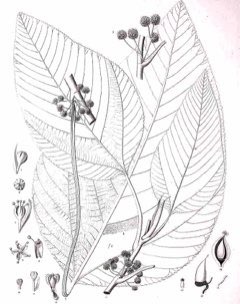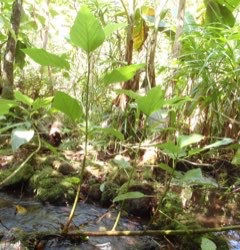 |
|
http://www.edibleplants.org |
 |
| Public Domain |
Translate this page:
Summary
Touchardia latifolia, commonly known as Olana, is a flowering shrub about 1 to 3 m tall endemic to Hawaii. The leaves, arranged alternately, vary in shape from thin lanceolate to broad elliptic. Female flowers are orange berry-like achenes while male flowers are white. No plant part is edible and of medicinal value. The bark yields strong, light, and water resistant fiber with is used for making fish lines, nets, in feather capes and helmets, musical instruments, weapons, fine cloth, etc. Plant is grown from cuttings. Transplanting is not ideal because the roots of Olana are fragile.
Physical Characteristics

 Touchardia latifolia is a SHRUB growing to 2 m (6ft 7in) at a slow rate.
Touchardia latifolia is a SHRUB growing to 2 m (6ft 7in) at a slow rate.
See above for USDA hardiness. It is hardy to UK zone 10.
Suitable for: light (sandy), medium (loamy) and heavy (clay) soils and prefers well-drained soil. Suitable pH: mildly acid, neutral and basic (mildly alkaline) soils. It can grow in full shade (deep woodland) or semi-shade (light woodland). It prefers moist or wet soil.
UK Hardiness Map
US Hardiness Map
Synonyms
No synonyms are recorded for this name.
Plant Habitats
Edible Uses
References More on Edible Uses
Medicinal Uses
Plants For A Future can not take any responsibility for any adverse effects from the use of plants. Always seek advice from a professional before using a plant medicinally.
None known
References More on Medicinal Uses
The Bookshop: Edible Plant Books
Our Latest books on Perennial Plants For Food Forests and Permaculture Gardens in paperback or digital formats.

Edible Tropical Plants
Food Forest Plants for Hotter Conditions: 250+ Plants For Tropical Food Forests & Permaculture Gardens.
More

Edible Temperate Plants
Plants for Your Food Forest: 500 Plants for Temperate Food Forests & Permaculture Gardens.
More

More Books
PFAF have eight books available in paperback and digital formats. Browse the shop for more information.
Shop Now
Other Uses
Basketry Fibre Musical String
Other Uses: A fibre obtained from the bark is strong, light, and water-resistant[417 ]. A very good quality fibre, highly prized for its tenacity and durability, it is used traditionally for making fish lines, netting, in feather capes and helmets, as well as ki-leaf rain capes, in musical instruments; in weapons such as daggers, clubs. Also used in conjunction with Freycinetia arborea in twined basketry[417 ]. The fibre is suitable for making fine cloth[454 ]. The plants are best cut when a little over a year old and their thick stems stripped of the loosely adhering bark[640 ]. The extraneous pulp is then scraped away the with a blade[640 ].
Special Uses
References More on Other Uses
Cultivation details
The plant grows best at elevations from 300 - 1,500 metres[640 ]. The plant flourishes best in a deeply shaded woodland position with hardly any clearing[640 ].
References Carbon Farming Information and Carbon Sequestration Information
Temperature Converter
Type a value in the Celsius field to convert the value to Fahrenheit:
Fahrenheit:
The PFAF Bookshop
Plants For A Future have a number of books available in paperback and digital form. Book titles include Edible Plants, Edible Perennials, Edible Trees,Edible Shrubs, Woodland Gardening, and Temperate Food Forest Plants. Our new book is Food Forest Plants For Hotter Conditions (Tropical and Sub-Tropical).
Shop Now
Plant Propagation
Seed -
Other Names
If available other names are mentioned here
Olona
Native Range
PACIFIC: United States (Hawaii (all islands except Ni‘ihau, Kaho‘olawe))
Weed Potential
Right plant wrong place. We are currently updating this section.
Please note that a plant may be invasive in one area but may not in your area so it's worth checking.
Conservation Status
IUCN Red List of Threatened Plants Status : This taxon has not yet been assessed

Growth: S = slow M = medium F = fast. Soil: L = light (sandy) M = medium H = heavy (clay). pH: A = acid N = neutral B = basic (alkaline). Shade: F = full shade S = semi-shade N = no shade. Moisture: D = dry M = Moist We = wet Wa = water.
Now available:
Food Forest Plants for Mediterranean Conditions
350+ Perennial Plants For Mediterranean and Drier Food Forests and Permaculture Gardens.
[Paperback and eBook]
This is the third in Plants For A Future's series of plant guides for food forests tailored to
specific climate zones. Following volumes on temperate and tropical ecosystems, this book focuses
on species suited to Mediterranean conditions—regions with hot, dry summers and cool, wet winters,
often facing the added challenge of climate change.
Read More
Expert comment
Author
Gaudich.
Botanical References
Links / References
For a list of references used on this page please go here
A special thanks to Ken Fern for some of the information used on this page.
Readers comment
| Add a comment |
|
If you have important information about this plant that may help other users please add a comment or link below. Only comments or links that are felt to be directly relevant to a plant will be included. If you think a comment/link or information contained on this page is inaccurate or misleading we would welcome your feedback at [email protected]. If you have questions about a plant please use the Forum on this website as we do not have the resources to answer questions ourselves.
* Please note: the comments by website users are not necessarily those held by PFAF and may give misleading or inaccurate information.
To leave a comment please Register or login here All comments need to be approved so will not appear immediately.
|
Subject : Touchardia latifolia
|
|
|
|